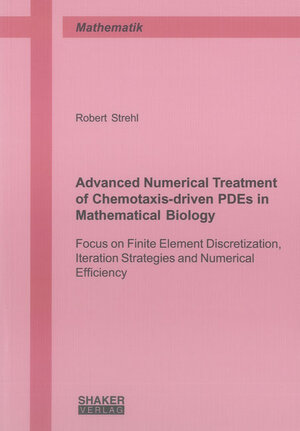
×
![Buchcover ISBN 9783844022841]()
Advanced Numerical Treatment of Chemotaxis-driven PDEs in Mathematical Biology
Focus on a Finite Element Discretization, Different Iteration Strategies and the Numerical Efficiency
von Robert StrehlFrom the first formulation of chemotaxis-driven partial differential equations (PDEs) by Keller and Segel in the 1970’s up to the present, much effort has been invested in modeling complex chemotaxis related processes. The sheer complexity of resulting PDEs crucially limits the postulation of analytical results. In this context, the support by numerical tools are of utmost interest which renders the implementation of a numerically well elaborated solver an undoubtedly important task.
This work presents different iteration strategies (linear/nonlinear, decoupled/monolithic) for chemotaxis-driven PDEs. The discretization follows the method of lines, where finite elements are employed to resolve the spatial discretization. Besides studying the numerical efficiency for particular chemotaxis-driven PDEs, the need for numerical stabilization is demonstrated. To this end, the flexible methodology of a scalar algebraic flux correction is applied which preserves the positivity of the fully discretized scheme under mild conditions. This work provides a first detailed study of accurate, efficient and flexible finite element schemes for chemotaxis-driven PDEs. The implemented numerical framework provides a promising basis for future applications to more complex models.
This work presents different iteration strategies (linear/nonlinear, decoupled/monolithic) for chemotaxis-driven PDEs. The discretization follows the method of lines, where finite elements are employed to resolve the spatial discretization. Besides studying the numerical efficiency for particular chemotaxis-driven PDEs, the need for numerical stabilization is demonstrated. To this end, the flexible methodology of a scalar algebraic flux correction is applied which preserves the positivity of the fully discretized scheme under mild conditions. This work provides a first detailed study of accurate, efficient and flexible finite element schemes for chemotaxis-driven PDEs. The implemented numerical framework provides a promising basis for future applications to more complex models.


